
LG had quite a disappointing year in 2015 due to lackluster sales of the LG G4. The G4 was a brilliant smartphone in many ways but still failed to gain momentum owing to a few factors. The primary factor being the build quality and materials used. Samsung had to find out the hard way about how essential the build quality and premium feel is for handsets, especially flagships. LG too have learnt that by now and their new flagship, the G5 is an indication of the new direction they are heading in. But there was a handset that was released last year that received lesser attention than it should, the LG V10. On paper at least, the smartphone seemed to offer one of the most complete packages in the flagship category. In this review, we will be taking a look at the smartphone in detail and seeing whether or not all the impressive features and specifications actually impress us in real life too.
Unboxing
We have already unboxed the LG V10 and the video can be seen below:
httpv://www.youtube.com/watch?v=KlRVox223UU
The contents of the box are:
- LG V10 Smartphone
- 2-pin Fast Charger (5V-1.8A/9V-1.8A)
- Micro USB cable
- LG QuadBeat 3 Headset with an extra set of earbuds
- 3000mAh battery
- Quick start guide
Design, Materials and Build Quality
The LG V10 is a large device mostly owing to the larger 5.7″ display compared to the 5.5″ display on the LG G4 or the 5.3″ unit on the G5. In fact, it’s one of the biggest 5.7″ devices in the market at the moment and has an even bigger footprint than the Nexus 6P from Huawei. At 8.6mm, it is one of the thicker ones too. However, it still feels quite easy to handle and use and definitely easier than the Nexus 6P to handle. I’m not sure what exactly the reason for this is but if I was to point a finger at something, then it would probably be the curves sides. The curved sides and back fit well into the palm of your hand and the smooth chrome finish too gives it a good feel.
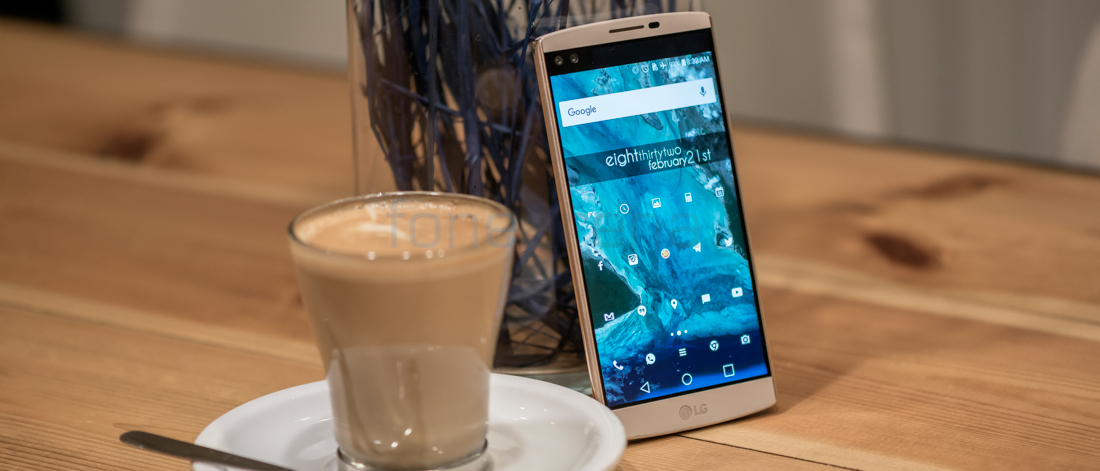
The entire smartphone feels really well-built and premium. While it doesn’t have a unibody design, the smartphone uses a lot of metal in the construction and that is why it is quite heavy too at 192 grams. But we aren’t complaining since that weight is very will distributed across the phone’s surface area. The added weight also has another reason which you will appreciate when you learn what it is. LG have used stainless steel for construction rather than the lighter aluminium (316L stainless steel which LG calls DuraGuard). The metal is more resistant to scratches compared to aluminium and the phone is also rated MIL-STD-810G as it is shock resistant. The steel frame makes sure that the phone doesn’t flex and thus makes sure that the glass doesn’t crack. it also has silicon bumpers on the corners to absorb impacts. While we haven’t dropped the phone during the time of review, it definitely does inspire confidence that in case you do, it’s still going to survive without any issues.
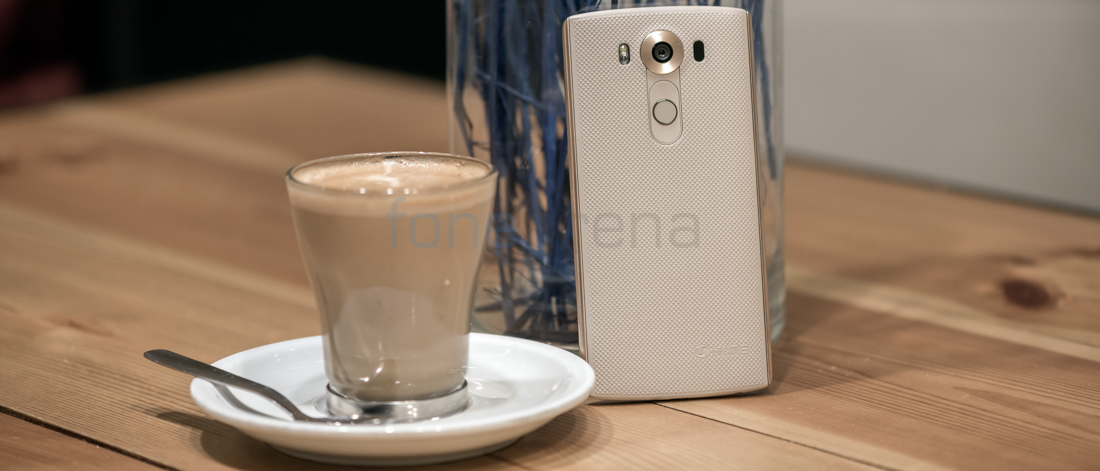
Additionally, the back panel too is made of a silicon like material called DuraSkin which LG claims is quite durable and 10 times more resistant to scratches as aluminium and twice as much as plastic. We can confirm that the back panel is really flexible and you surely won’t be able to break it accidentally. The back cover also provides a lot of grip and possibly the main attraction is that it isn’t a fingerprint magnet like almost every other phone in the market. The back panel is removable and it gives you access to the nanoSIM slot, microSD card slot and the battery which is removable as well.
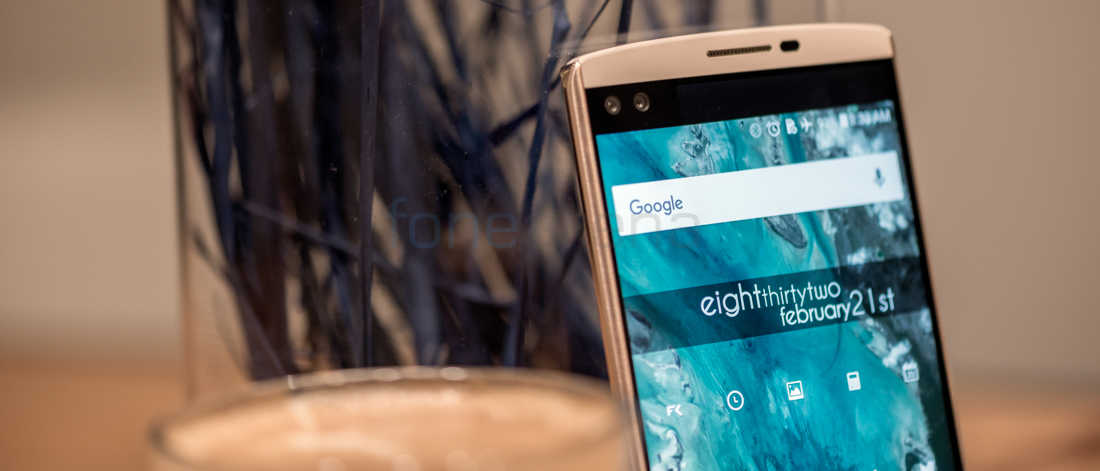
The V10 is available in 5 different colours – Space Black, Luxe White, Modern Beige, Ocean Blue and Opal Blue. The variant we have is the Modern Beige. The front and the back have a nice beige colour while the sides and the camera ring have a gold finish that is somewhere between Gold and Rose Gold. The Luxe White, Ocean Blue and Opal Blue variants also share the same coloured accents. The back cover too has the same dotted pattern which provides additional grip except for the Ocean Blue which has a different back cover like the Space Black. The Space Black variant also has silver coloured accents instead of the Gold ones found on the other variants.
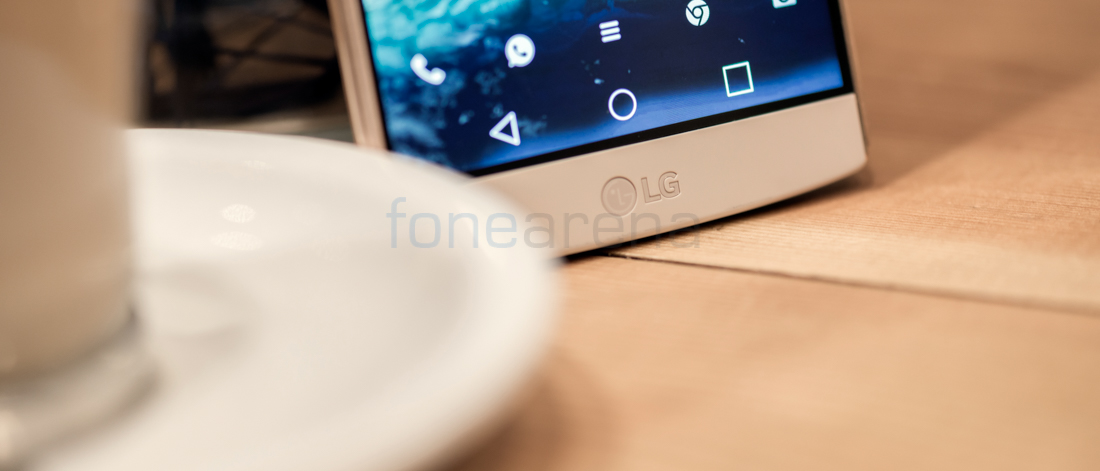
The front of the device is dominated by the 5.7″ display above which you find the two front facing cameras as well as the secondary 2.1″ screen. Above those, you have the earpiece as well as the ambient light and proximity sensors. Below the display, you just have a fat chin that houses the LG logo.
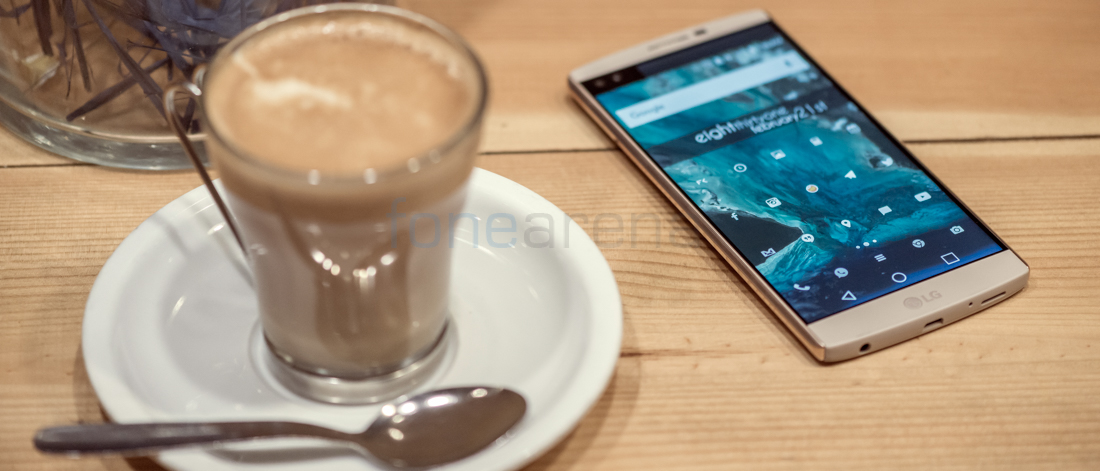
At the bottom of the phone, you have the 3.5mm audio jack, microUSB port, primary microphone and speaker grille. At the top, you have the IR blaster and secondary microphone.
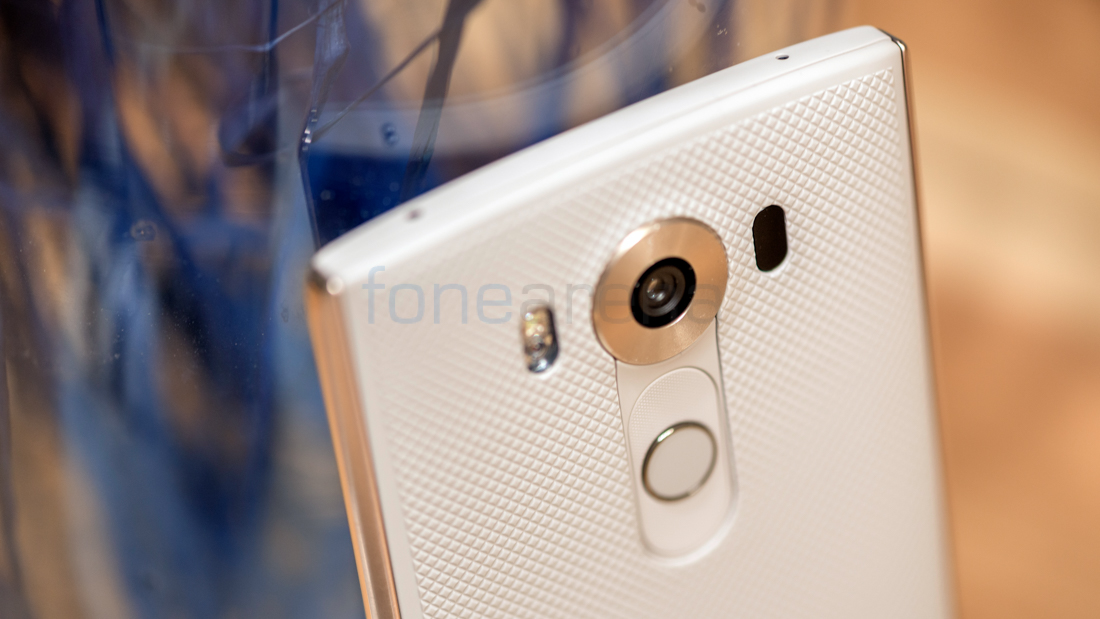
Things are empty at the sides since the volume controls and power button is mounted at the back of the phone just below the camera module. This time around, there is a fingerprint sensor within the power button which we shall talk about in detail later on. The camera module has a large ring around it which I personally feel ruins the flow of the design a bit. I don’t mind the ring much but I do find that the size of the ring is out of proportion. Something a little thinner would’ve looked better on it perhaps. On either side of the camera module, you have the dual tone LED flash and the laser AF.
Display
5.7 inches is probably the perfect size for a phablet screen at least in my book. The LG V10 is a bit larger for a phone with such a screen size but there is another reason for it. There is a 2.1″ secondary display above the primary one that can function independently. The primary screen has a resolution of 1440p while the secondary one has a resolution of 160×1040. That’s because most of the left side of the secondary display is taken up by the dual front facing cameras. So while it does look like the display covers the full width of the primary display, it actually stops a bit short.
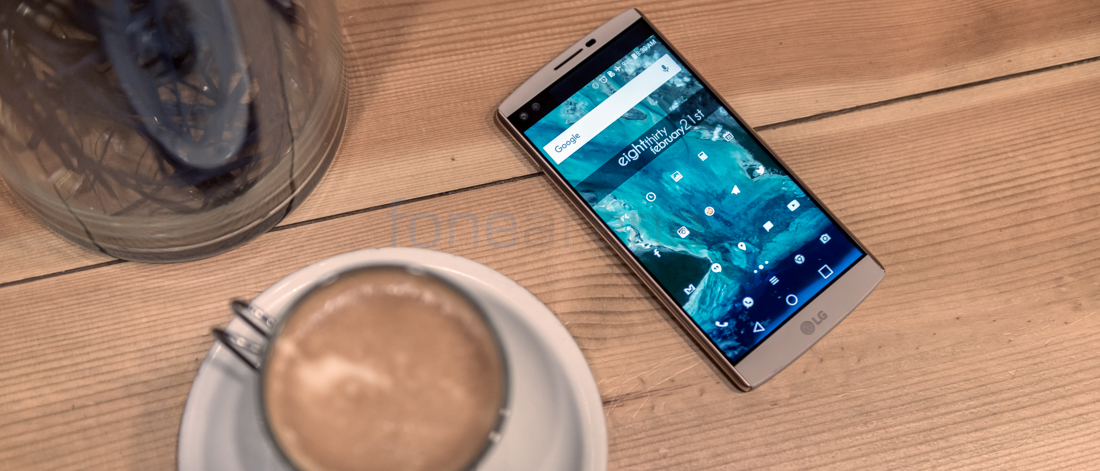
The display is protected by Corning Gorilla Glass 4 which is really good and in our extensive time with the device, we haven’t gotten any scratches apart from just a tiny scuff on the screen but we aren’t actually sure what caused it. It is indeed quite durable and along with the shock resistance and body that won’t flex, the smartphone should be fine even if you drop it from a reasonable height. The primary display is really good in terms of brightness indoors but the sunlight legibility is hampered a bit owing to the reflective glass. The colours are great and so is the contrast level especially for an IPS panel.
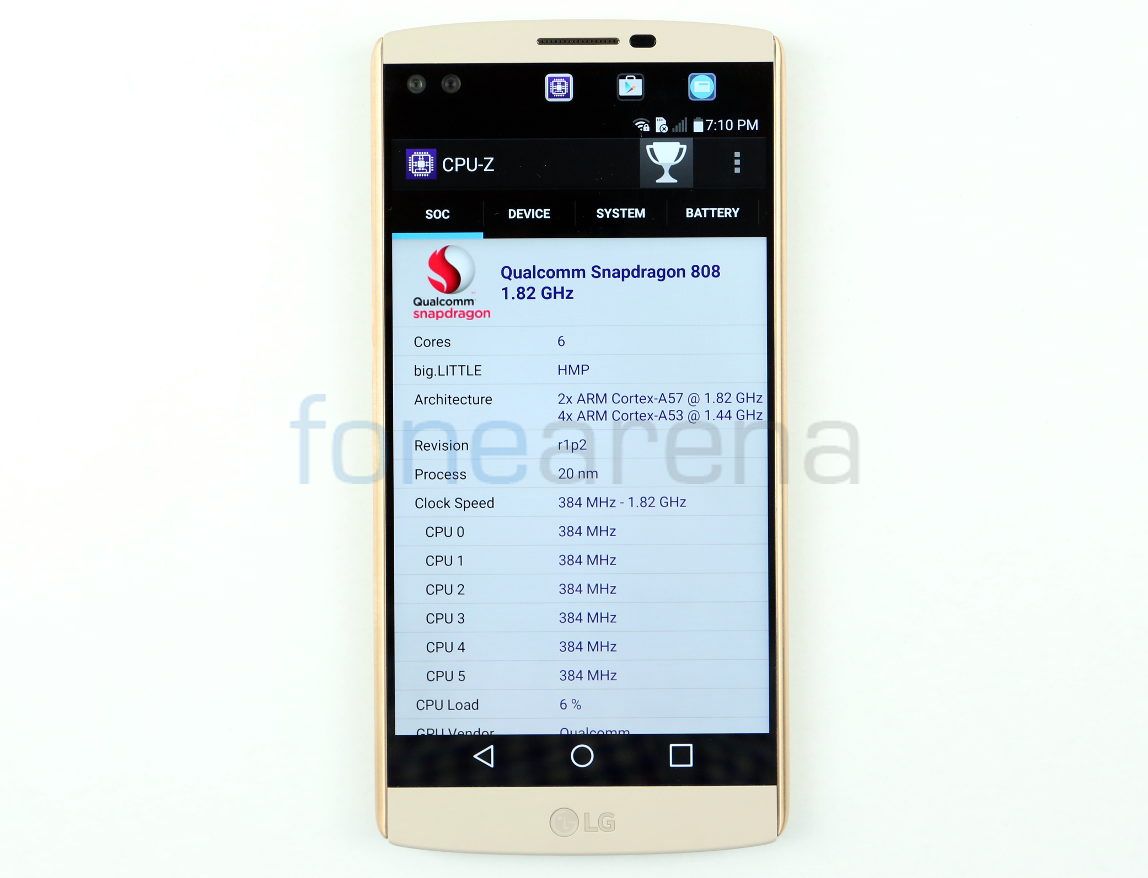
The second display can be kept on when the primary display is on or off or both and can also be turned off completely. The main purpose of the secondary display when the main screen is off is to provide you with the time, date, battery life and notifications without having to wake up the phone. It is similar to the Always On display technology but instead of having the main screen perform that function, you have a secondary display to do it. When the screen is on, the secondary display can display details of notifications, provide shortcuts to apps, settings etc. it is a fully functioning touchscreen so you can have 3 different screens to show you various shortcuts that are customisable as well. It can also have a custom signature with your name or a phrase in the font you choose.
Turning on the secondary display does consume more battery but not too much that you would end up having to switch it off completely. I personally found it quite useful to have it turned on when the primary display was off since I didn’t have to wake up the device every few seconds to check for notifications. However, I didn’t really find it very helpful to use when the main display was turned on. The primary reason for this is that the display is quite far up and even for a person like me with big hands and long fingers, it takes quite a bit of travel to access the secondary display.
Fingerprint Scanner
One of the main things that the LG G4 lacked compared to competitors is a fingerprint sensor. Luckily, the V10 has one and the fingerprint scanner is located at the back within the power key. It’s surprising how LG have managed to pack one in there as that is one location where there is likely to be plenty of connectors going around since there are 3 keys, a camera module, dual-tone LED flash and laser AF.
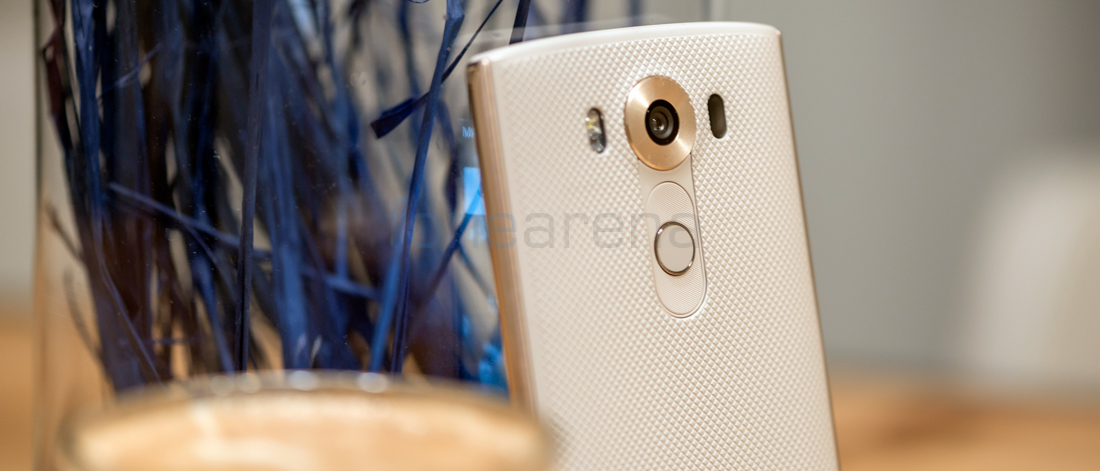
However, what I don’t like is the implementation. The power key is probably the only hardware part that feels out-of-place since it is quite loose. It wobbles a bit and takes away the premium feel that rest of the handset provides. The fingerprint sensor is quick to unlock the phone as well but the accuracy is quite poor especially when compared to other flagships on the market. Most often than not, we had the sensor failing to recognise the fingerprint. If your finger or the sensor is remotely wet or dirty, it fails to recognise it. We tried unlocking other phones side by side and they were able to do so just fine. In fact, even if you use a hand sanitiser, the phone fails to recognise your fingerprint. However, phones such as the Note5, Nexus 6P etc have no such problems.
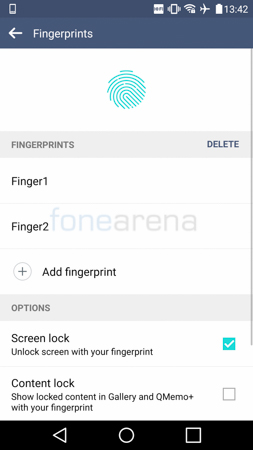
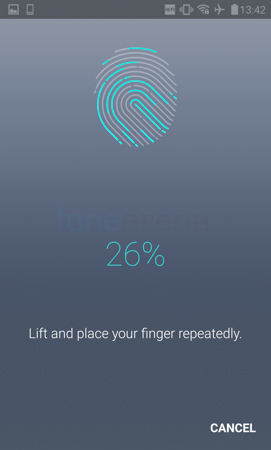
Registering a fingerprint is usual business. You first set a PIN or Pattern or password as a backup in case your fingerprint sensor fails to work and as experience taught us, it is something really needed on the V10. Then you add your finger by placing it repeatedly over the sensor several times and you have to even feed in your fingertips for better accuracy. Once done, you can use your fingerprint to gain access to the phone or apps or the PayNow service which is supported in Korea. The update to Android 6.0 Marshmallow should bring you even more uses cases for your fingerprints.
In order to unlock the phone, the user needs to first wake the phone up by double tapping the screen and then placing your finger on the sensor or by pressing the power button and then placing your finger on the sensor. You can similarly lock the device either by double tapping the status bar or by pressing the power key.
Calls and Messaging
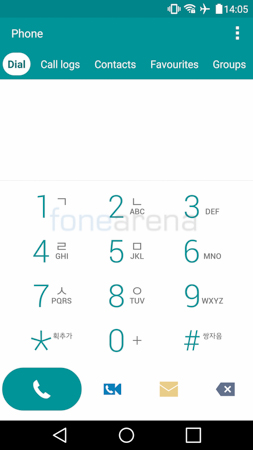

The LG V10 has really good audio quality over the earpiece and the volume is good enough for noisy environments too. The secondary mic does a good job at cancelling outside noise and relaying your voice clearly to the other side. The loudspeaker too is quite clear but lacks a bit in terms of volume. The dial pad is large and easy to use. You can either enter a number or search for a contact after which you can choose to make a voice call, video call or send a message.
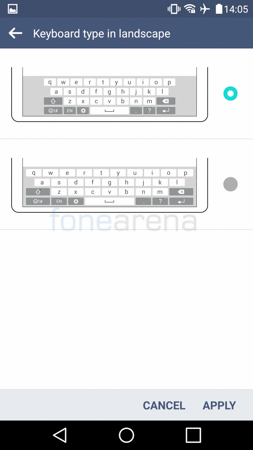
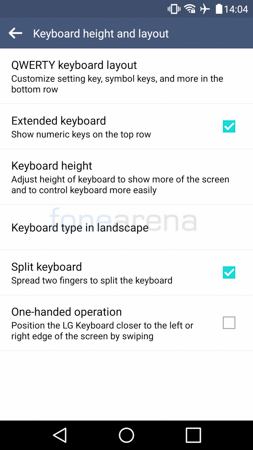
The keyboard that comes by default is the LG keyboard which is really customizable. it is available in several different languages and you can have a White or Black theme. In landscape mode, users can choose the keyboard layout to be more concentrated to the centre with less letter travel or to occupy the full width of the screen. They can also opt to have a split keyboard by swiping two fingers apart. Users can also enable or disable the numeric row at the top, adjust the height of the keyboard etc. It also supports key tracing and is a really capable keyboard overall. Coupled with the large screen, it is quite a capable messenger. You can choose to install any 3rd party keyboard of your liking if you don’t like what LG has included.
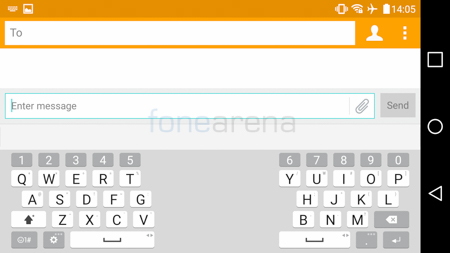
Software and UI
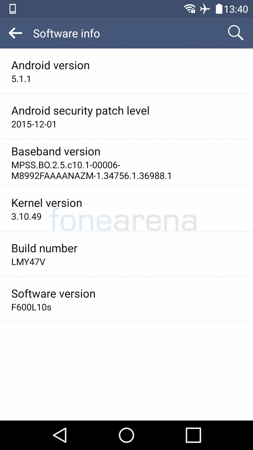
The LG V10 comes with Android Lollipop 5.1.1 at the time of writing this review. It should eventually get the update to Android 6.0 Marshmallow but considering that it isn’t really available the world over, we aren’t sure how much of a priority it is on LG’s update schedule and thus it could get it quite late. The LG V10 comes with several customisations to the general UI and usability of Android.
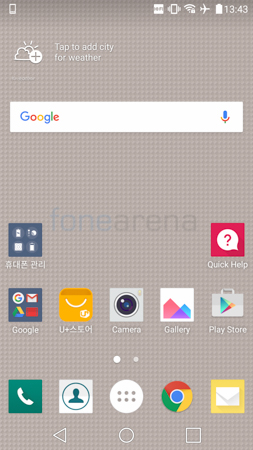
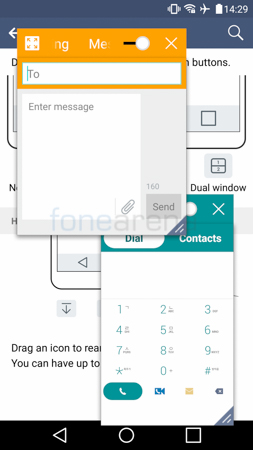
LG have included several ways for users to facilitate one-handed usage since the device has a large screen and footprint. The keyboard, dialer etc. can be moved towards on side of the display for easier access. Similarly, you can just tap on a portion of the display and the pattern dots to unlock the phone will appear there on a smaller scale. Since the smartphone has on-screen keys, LG allows users to customize the layout. You can have up to 5 buttons at the bottom which LG refers to as Home Touch buttons. By default, you have the home key, the return key and multi-tasking key which are non-removable but can be re-arranged as per your preference. You can add a Capture+ shortcut, a notification pull button, QSlide shortcut and a Dual Window shortcut.
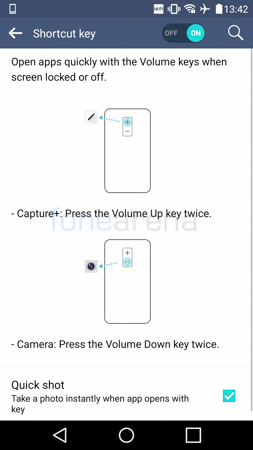
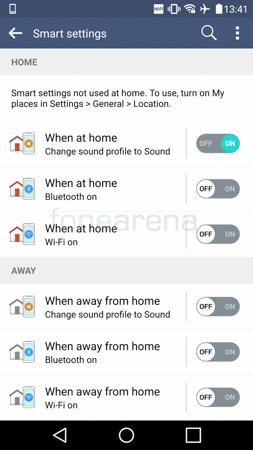
Capture+ is basically an advanced screenshot tool that allows you to edit and crop the screenshot. It is also easier to capture a screenshot this way since holding down the volume down button and power key at the back is difficult at times. The Notification pull button brings down the notification drawer by just clicking the button rather than having to drag it from the top to the bottom. A second click will retract it as well. Dual Window and QSlide makes use of the large screen estate. Dual Windows allows the screen to show two apps simultaneously at the top and bottom. QSlide on the other hand has miniature versions of apps that can be dragged and resized to any part of the screen. You can have multiple QSlide apps open at once and you can also adjust their opacity to make them less intrusive.
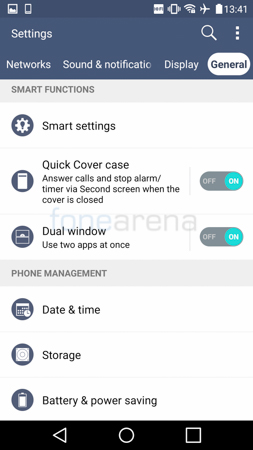
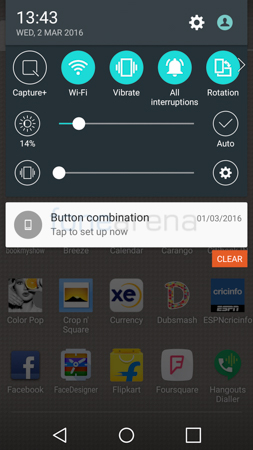
Smart settings allow the user to create a set of actions to be performed by the phone when it detects a certain location. For example, you can ask the phone to switch on Wi-Fi and change from Vibrate to General mode when it detects that you have reached home. Mini view allows you to make the entire UI smaller and move it around to make one-handed usage easier. Shortcut keys basically makes use of the volume up and volume down buttons when the screen is off. Double tapping the volume up button will open up Capture+ while the volume down button will open the camera app. You can even set the phone to automatically capture a photo once the app is open.
Storage, Connectivity and Performance
The LG V10 is available in both 32GB and 64GB variants. it also has a dedicated microSD card slot that makes sure that you have enough space for all your storage needs. Cards up to 200GB are supported and the device has a microUSB port that support OTG functionality as well. It supports dual-band Wi-Fi a/b/g/n/ac as well as Bluetooth 4.1. It takes a nanoSIM card and supports 4G LTE networks too. Certain regions will also receive a dualSIM variant but most of the markets will have to make do with the single SIM variant.
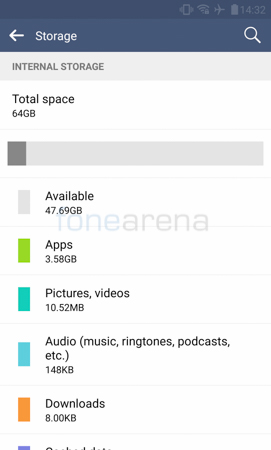
The smartphone is powered by a hexa-core Snapdragon 808 processor which is the same as the LG G4. It has 4GB of RAM and an Adreno 418 GPU as well. The performance is quite fast and we rarely had any issues when gaming or multi-tasking. There is a bit of lag occasionally mostly owing to the UI customisations but not too noticeable and the phone never hung up on us as such. You can check out our full benchmarks video of the LG V10 below.
httpv://www.youtube.com/watch?v=n3531mCJxAI
For the full-fledged benchmark results, check out this article.
Music Player and Audio Quality
The LG V10 comes with a music player that supports a wide variety of audio formats including FLAC. It can play songs that are stored locally on your device as well as files that are stored on the cloud in accounts such as OneDrive, Dropbox, Box, Google Drive or LG’s own U+ Box. Songs can be grouped and arranged according to the title, album, genre, folder, artists and folders. You can scroll through the list or jump to any alphabet by using the letter shortcuts at the right side. The now playing screen gives you the track controls, album art as well as options to set shuffle, repeat, favourite etc. Users can also add tracks to their playlists, set as ringtone, share or even search for the music video directly from the music player which will redirect you to the YouTube app.

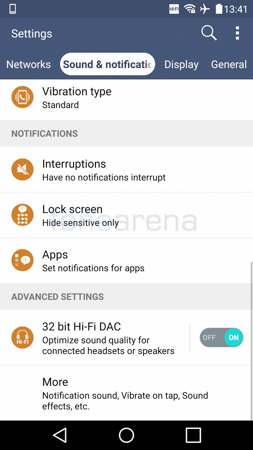
LG has a Hi-Fi plug-in that allows you to up sample your 16-bit audio files to 24 bit and as a result improves the audio quality. The phone has really good audio quality over headphones or earphones. The dynamic range is quite good and stereo crosstalk is minimal. If you enable the 32 bit DAC, you can adjust the balance between left and right ears as well as get 75 levels of precise volume control. Try listening to some lossless audio over the V10 and you’ll really know that it is one of the best sounding smartphones on the market if not the best.
The speaker is good in terms of clarity but lacks a bit in terms of loudness. It should be fine to listen amongst a small group of friends but will definitely get drowned out at a party for example. The V10 does have FM radio in certain regions but on our particular variant, this feature was missing and hence we weren’t able to try that out.
Camera
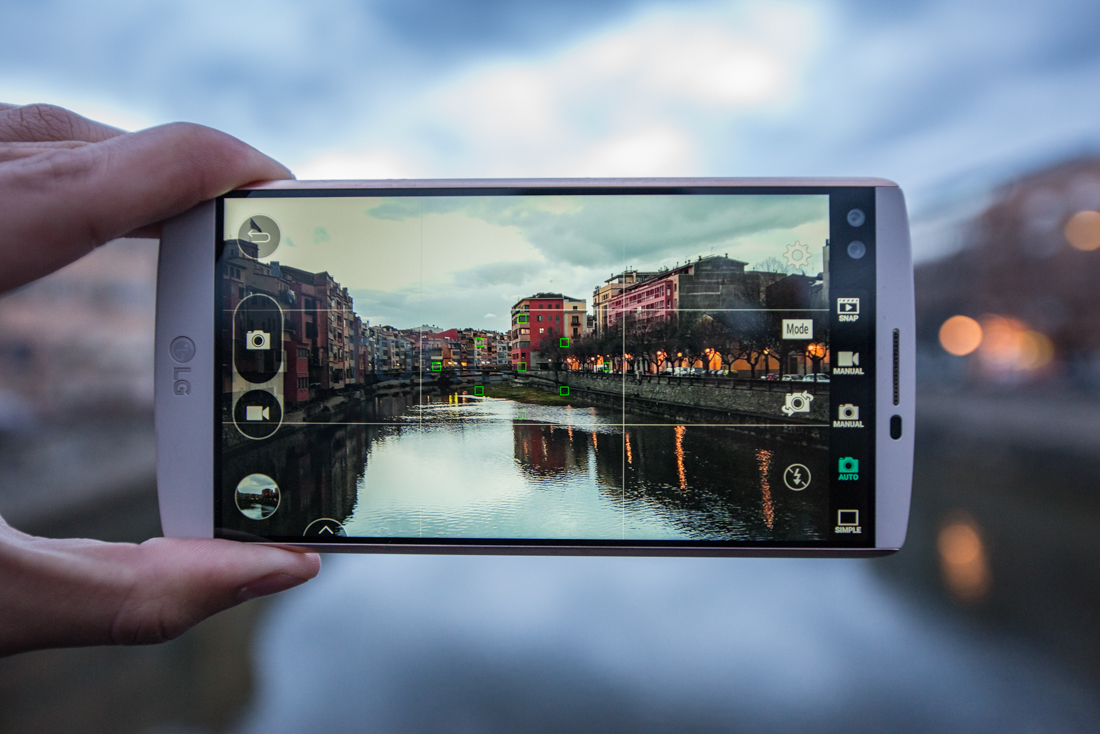
The LG V10 has pretty much the same hardware specs for the main camera as the G4 and in this case it is a good thing. The LG G4 had a great camera. It was quick, sharp and detailed. The camera has a resolution of 16 Megapixels with an aspect ratio of 16:9 and an f/1.8 aperture which was one of the best in the industry until recently when Samsung announced the f1.7 lenses on the S7 and S7 Edge. The sensor size is 1/2.6″ and the camera has OIS (Optical Image Stabilisation) as well. The camera has really good dynamic range and the details it is able to capture is almost unparalleled. The Note5 and S6 devices too can’t compete with the V10 in terms of the details it can capture. The camera supports RAW image capture in .DNG format and that really makes the maximum use of the smartphones camera. You can see some samples below where the RAW image is on the left and the JPG file is on the right. We haven’t edited the RAW image in any way but yet you can see how much more of a dynamic range it has and how much more details the camera retains compared to the JPG files which are compressed. Don’t get me wrong, the JPG files are quite impressive too but doesn’t really showcase the full potential that the camera has.
If you prefer to let the smartphone do most of the processing and want a higher dynamic range, the HDR mode does a splendid job too. You can take a look at the HDR samples on the left and the normal shots at the right.
What is great about the V10 is the incredibly detailed manual mode that it offers. You can set the shutter speed, ISO, White Balance, focus, etc. manually. You can even get several assists such as a histogram, level, grid etc. that will help you to compose and capture your photo better. The phone allows you to take really long shutter photos too as the maximum exposure time goes all the way up to 30 seconds which is really great to see on a smartphone.
What is even more amazing is that for the first time in a smartphone, you have a completely manual video mode too. You can choose the video recording resolution and frame rate. UHD (4K) videos max out at 30 fps while 1080p videos and 720p videos max out at 60 fps and 120 fps respectively. The camera even offers a cinema mode in 1080p and 720p resolution which means you can have an awesome 21:9 aspect ratio for your videos. After choosing the resolution and frame rate, users can also specify the bitrate. In case of 4K videos, the options are 30mbps, 48mbps and 64mbps.
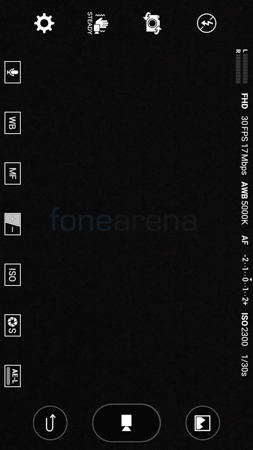
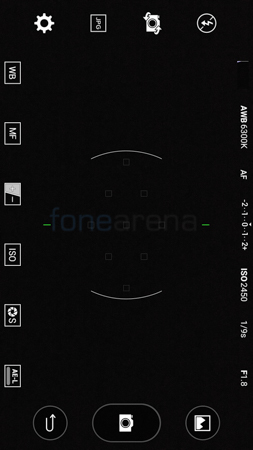
This video below which we used as an intro for our MWC 2016 coverage was shot on a tripod with the LG V10 at the lowest 30mbps settings. We initially did the shot with my Nikon D800e but after we tried the same with the V10, we went ahead with the one shot on the smartphone. That itself should give you a rough idea about the capabilities of the camera especially in terms of video.
httpv://www.youtube.com/watch?v=IWvDcY4ttFo&feature=youtu.be
This video too was shot with the same settings at 30mbps but handheld:
httpv://www.youtube.com/watch?v=AT9n2LgItW4&feature=youtu.be
And finally, you have a timelapse video sample as well:
httpv://www.youtube.com/watch?v=EbP-YsFJ640&feature=youtu.be
The LG V10 also innovates with its dual-camera setup up front. Both the cameras have a resolution of 5 Megapixel but one offers an 80 degree FoV (Field of View) while the other offers a 120 degree FoV. The 120-degree camera is definitely impressive and while its cool to have two separate cameras, we feel that LG should’ve probably just put one in and that the secondary one wasn’t entirely necessary. An 8 megapixel 120-degree camera upfront would’ve been more than enough. Even if you are taking a solo selfie, you would have enough resolution to crop into. The wide-angle makes sure that you can easily get a group selfie in or also if you want more of the background. The quality isn’t that great and there is considerable noise especially in low light. We’ve seen better quality front facing cameras on phones but it still is good enough for your social media purposes.
Battery Life
The LG V10 comes with a removable battery with a capacity of 3000mAh. While that capacity was used on phones such as the Note5 and S6 edge+, they fared better in our battery life tests. The LG V10 got a one charge rating of just 8 hours and 54 minutes in our battery tests. That is quite low and means that you definitely have to charge your device more than once a day especially if you are a heavy user. One advantage of the V10 is the removable battery so you could buy a spare battery and couple it with one of the battery charging adapters that LG has in order to always have a spare battery that’s fully charged. If you have one, then going from an empty battery to a full charge is just a matter of a few seconds. However, that solution isn’t ideal for all of us and there is no true replacement for battery life itself.
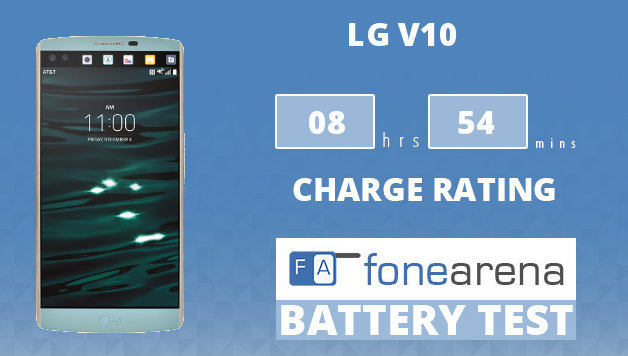
The main issue is in terms of software optimisation so we hope, LG does something to improve the battery life. Once they update it to Android 6.0 Marshmallow, we should get better results especially with Doze preventing too much battery drain on standby. When you do run out of juice, the smartphone will recharge quite quickly thanks to the Qualcomm QuickCharge 2.0 rating. For the full-fledged battery life results, visit this post.
Conclusion
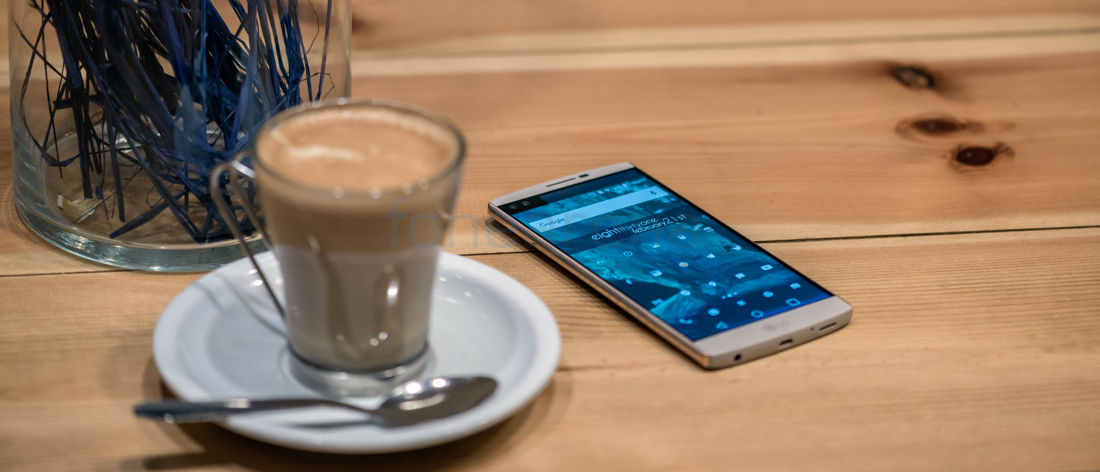
The LG V10 may be a bit old in smartphone terms. But it offers a really exciting and different set of features in a package that is quite unique. Although the LG G5 is the latest flagship from LG, the V10 does hold its own still and comes with some features that even the G5 can’t compete with. The secondary display, the dual front facing cameras, shock resistance, manual video mode etc. are features that are lacking in almost every other mainstream flagship smartphone including other offerings from LG. The V10 is probably one of my favourite smartphones of 2015 and it is definitely still a strong contender for the year 2016 for those who are looking for a different experience and a smartphone that needs very little compromises. The only issue is availability. LG hasn’t introduced the V10 official in many markets such as India and with the launch of the G5 nearing, we aren’t sure if they ever will. If you are fine with sourcing a unit from another country, then it is probably worth the trouble since the V10 is a splendid smartphone. The only thing you need to be careful is to get it from a region that supports your local LTE bands and that the unit you are buying is unlocked.
Pros
- Brilliant Build Quality and Premium Feel
- Rugged and Refreshing Design
- Great Camera Quality
- Manual Imaging and Video Modes with RAW Support and Bitrate Options
- Great Audio Quality
- Good Display with Secondary Display
- Removable Battery
- Expandable Memory
Cons
- Fingerprint Sensor Isn’t Always Accurate
- Battery Life Not Good Enough
Siraj contributed to this review














